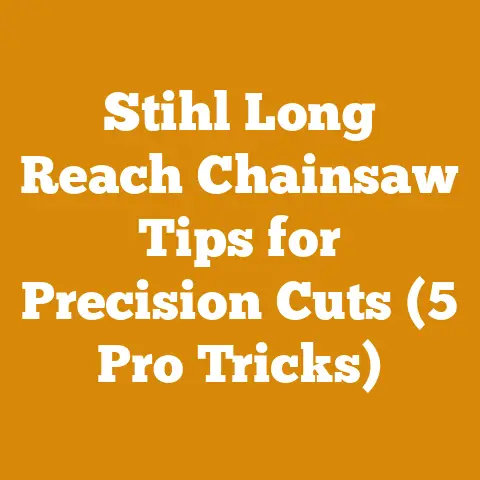How to Sharpen Band Saw Blades (5 Pro Tips for Long-Lasting Cuts)
Ever felt like your bandsaw blade is cutting through butter one day and struggling with oak the next? Are you tired of replacing blades that seem to dull way too quickly? The secret to long-lasting, efficient cuts isn’t just about buying the best blade; it’s about mastering the art of sharpening. I’ve spent countless hours in my own workshop, and in the forests observing seasoned loggers, figuring out the nuances of bandsaw blade maintenance. Let me share with you five pro tips that will not only extend the life of your blades but also improve the quality and speed of your cuts.
The Lifeline of Your Bandsaw: Why Sharpening Matters
Before we dive into the how-to, let’s understand the why. A sharp bandsaw blade is more than just a convenience; it’s crucial for safety, efficiency, and the quality of your work. A dull blade requires more force, increasing the risk of kickback and potentially damaging your workpiece or even yourself. Think of it like this: a dull knife in the kitchen is far more dangerous than a sharp one because you need to apply more pressure, making slips more likely.
Beyond safety, a sharp blade means cleaner, faster cuts. I remember one project where I was resawing some thick cherry boards for a custom cabinet. With a dull blade, I was fighting the wood, creating uneven surfaces and burning the edges. Once I sharpened the blade, the difference was night and day. The cuts were smooth, the feed rate increased, and the project moved forward seamlessly.
The Economics of Sharpness
Let’s talk numbers. Bandsaw blades can range from a few dollars for a small, general-purpose blade to upwards of $50 or more for specialized, high-performance ones. If you’re constantly replacing blades due to dullness, the costs can quickly add up. Sharpening, on the other hand, can be done for a fraction of the cost, using relatively inexpensive tools and supplies.
Consider this scenario: You’re a small woodworking shop owner, and you go through an average of 10 bandsaw blades per year at $30 each. That’s $300 annually. By investing in sharpening equipment and mastering the techniques, you could potentially reduce your blade consumption by 50% or more, saving you hundreds of dollars each year.
Data Point: A study by the Forest Products Laboratory found that properly sharpened bandsaw blades can reduce energy consumption by up to 20% compared to dull blades, leading to further cost savings in electricity.
Understanding Your Bandsaw Blade: A Quick Anatomy Lesson
Before you start sharpening, it’s essential to understand the anatomy of your bandsaw blade. Each tooth has three main parts:
- The Face: The leading edge of the tooth that does the cutting.
- The Back: The trailing edge of the tooth.
- The Gullet: The curved area between the teeth that clears away chips.
The sharpness of the blade depends primarily on the condition of the face. As the blade dulls, the face becomes rounded and loses its sharp edge. Sharpening aims to restore that sharp edge by removing a small amount of material from the face.
Different Tooth Geometries: Understanding the Rake Angle
Bandsaw blades come in various tooth geometries, each designed for specific cutting applications. One of the most important aspects of tooth geometry is the rake angle, which is the angle of the tooth face relative to a line perpendicular to the blade.
- Positive Rake Angle: The tooth face leans forward, providing a more aggressive cut. These blades are ideal for softer woods and faster feed rates.
- Zero Rake Angle: The tooth face is perpendicular to the blade. These blades are suitable for general-purpose cutting.
- Negative Rake Angle: The tooth face leans backward, providing a smoother cut and reducing the risk of tear-out. These blades are often used for cutting hardwoods and non-ferrous metals.
Understanding the rake angle of your blade is crucial for selecting the appropriate sharpening technique and ensuring that you maintain the correct geometry during the sharpening process.
Pro Tip #1: Invest in the Right Sharpening Tools
Trying to sharpen a bandsaw blade with the wrong tools is like trying to build a house with only a hammer. You might get something done, but it won’t be pretty, efficient, or long-lasting. Here are the essential tools you’ll need:
- Bandsaw Blade Sharpener: These come in manual and electric versions. Manual sharpeners are more affordable and offer greater control, while electric sharpeners are faster and more consistent. I prefer a manual sharpener for its precision and tactile feedback.
- Magnifying Glass or Loupe: This is crucial for inspecting the teeth and ensuring that you’re sharpening them evenly. A 10x magnification is ideal.
- Dial Caliper: This tool is used to verify the uniformity of the tooth height and set.
- Tooth Setter: The set of a bandsaw blade refers to the amount that the teeth are bent to the sides. This creates clearance for the blade body to pass through the cut. A tooth setter is used to restore the set after sharpening.
- Cleaning Supplies: A clean blade is a happy blade. Use a wire brush and solvent to remove any resin or debris from the blade before sharpening.
Manual vs. Electric Sharpeners: A Detailed Comparison
Choosing between a manual and electric bandsaw blade sharpener depends on your budget, the volume of blades you need to sharpen, and your personal preference.
Manual Sharpener:
- Pros:
- Lower cost
- Greater control and precision
- No electricity required
- More tactile feedback
- Cons:
- Slower sharpening process
- Requires more skill and practice
- Can be more tiring for large volumes of blades
Electric Sharpener:
- Pros:
- Faster sharpening process
- More consistent results
- Less physically demanding
- Cons:
- Higher cost
- Less control and precision
- Requires electricity
- Can generate more heat, potentially damaging the blade
In my experience, a manual sharpener is the best choice for hobbyists and small workshops that value precision and control. Electric sharpeners are better suited for larger operations that need to sharpen a high volume of blades quickly.
Pro Tip #2: Master the Art of Visual Inspection
Before you even think about sharpening, take the time to thoroughly inspect your blade. This will help you identify any damage, assess the level of dullness, and determine the best approach for sharpening.
- Look for Broken or Missing Teeth: These need to be addressed before sharpening. If a tooth is broken, you may be able to grind it down to create a new tooth profile. If a tooth is missing, the blade may need to be replaced.
- Check for Cracks: Cracks can weaken the blade and lead to breakage. If you find any cracks, discard the blade immediately.
- Examine the Tooth Faces: Look for rounding or flattening of the cutting edges. This is a clear sign of dullness.
- Inspect the Gullets: Check for any buildup of resin or debris. This can interfere with the cutting process and accelerate wear.
The Power of Magnification: Seeing the Unseen
Using a magnifying glass or loupe is essential for detecting subtle signs of dullness or damage that may not be visible to the naked eye. Under magnification, you’ll be able to see the condition of the cutting edges in detail, allowing you to make informed decisions about sharpening.
I remember one instance where I was sharpening a bandsaw blade that seemed to be cutting fine. However, when I inspected it under magnification, I noticed tiny micro-cracks along the cutting edges. These cracks were not visible to the naked eye, but they were a clear indication that the blade was nearing the end of its life. By catching these cracks early, I was able to replace the blade before it broke during a critical project.
Pro Tip #3: Sharpen with Precision and Consistency
Sharpening a bandsaw blade is not a race; it’s a delicate process that requires patience and attention to detail. The key is to sharpen each tooth evenly and consistently, maintaining the original tooth geometry.
- Follow the Manufacturer’s Instructions: Each sharpener is slightly different, so it’s essential to read and understand the manufacturer’s instructions before you begin.
- Use Light Pressure: Applying too much pressure can damage the blade or alter the tooth geometry. Let the sharpener do the work.
- Maintain a Consistent Angle: The angle at which you sharpen the tooth face is crucial for maintaining the blade’s cutting performance. Use a guide or jig to ensure that you’re sharpening at the correct angle.
- Sharpen Each Tooth Equally: This is essential for ensuring that the blade cuts smoothly and efficiently. Use a magnifying glass to check your work and make sure that each tooth is sharpened to the same degree.
The Importance of Coolant: Preventing Overheating
During the sharpening process, the friction between the blade and the sharpening wheel can generate heat. Excessive heat can damage the blade, altering its temper and reducing its cutting performance. To prevent overheating, it’s essential to use a coolant.
- Water: Water is a simple and effective coolant. Apply a small amount of water to the blade during sharpening to keep it cool.
- Cutting Oil: Cutting oil is a more specialized coolant that provides better lubrication and cooling than water. It also helps to prevent rust and corrosion.
I prefer to use cutting oil when sharpening bandsaw blades because it provides superior cooling and lubrication. However, water is a perfectly acceptable alternative if you don’t have cutting oil on hand.
Pro Tip #4: Restore the Set of the Teeth
As mentioned earlier, the set of a bandsaw blade refers to the amount that the teeth are bent to the sides. This creates clearance for the blade body to pass through the cut. Over time, the set can diminish due to wear and tear, reducing the blade’s cutting performance.
After sharpening, it’s essential to restore the set of the teeth using a tooth setter. This tool allows you to precisely bend the teeth to the correct angle, ensuring that the blade has adequate clearance.
- Use the Correct Tooth Setter: There are different types of tooth setters available, each designed for specific blade sizes and tooth geometries. Make sure you’re using the correct tooth setter for your blade.
- Follow the Manufacturer’s Instructions: Tooth setters can be tricky to use, so it’s essential to read and understand the manufacturer’s instructions before you begin.
- Check the Set with a Dial Caliper: After setting the teeth, use a dial caliper to verify that the set is uniform across the blade.
The Art of Setting: Finding the Right Balance
The amount of set required for a bandsaw blade depends on the type of wood you’re cutting and the thickness of the blade. Softer woods generally require more set, while harder woods require less. Thicker blades also require more set than thinner blades.
Finding the right balance between set and cutting performance is an art that comes with experience. However, a good starting point is to follow the manufacturer’s recommendations for your specific blade and wood type.
Pro Tip #5: Regular Maintenance is Key
Sharpening your bandsaw blades is not a one-time event; it’s an ongoing process that requires regular maintenance. The more often you sharpen your blades, the less material you’ll need to remove each time, and the longer your blades will last.
- Sharpen After Every Use: This may seem excessive, but it’s the best way to maintain peak cutting performance. Even if the blade doesn’t feel dull, a quick touch-up after each use will keep it in top condition.
- Clean Your Blades Regularly: Resin and debris can accumulate on the blade, interfering with the cutting process and accelerating wear. Clean your blades regularly with a wire brush and solvent.
- Store Your Blades Properly: When not in use, store your blades in a dry, protected environment to prevent rust and corrosion.
The Power of Prevention: Avoiding Damage
Prevention is always better than cure. By taking steps to prevent damage to your bandsaw blades, you can extend their lifespan and reduce the need for frequent sharpening.
- Use the Correct Blade for the Job: Using the wrong blade for the job can lead to premature dulling and damage. Make sure you’re using the correct blade for the type of wood you’re cutting and the thickness of the material.
- Avoid Cutting Metal: Bandsaw blades are designed for cutting wood, not metal. Cutting metal can quickly dull or damage the blade.
- Adjust Your Feed Rate: Forcing the blade through the wood can lead to overheating and damage. Adjust your feed rate to match the hardness of the wood and the sharpness of the blade.
Beyond the Basics: Advanced Sharpening Techniques
Once you’ve mastered the basic sharpening techniques, you can explore some advanced methods to further improve the performance of your bandsaw blades.
Gullet Grinding: Optimizing Chip Clearance
The gullet is the curved area between the teeth that clears away chips. Over time, the gullet can become clogged with resin and debris, reducing its capacity and interfering with the cutting process. Gullet grinding involves using a specialized grinding wheel to clean and reshape the gullet, optimizing chip clearance and improving cutting performance.
Tooth Profiling: Customizing Tooth Geometry
Tooth profiling involves altering the shape of the tooth to suit specific cutting applications. For example, you can modify the rake angle to create a more aggressive or smoother cut, or you can add a chip breaker to reduce tear-out. Tooth profiling requires specialized tools and skills, but it can significantly improve the performance of your bandsaw blades.
Case Study: Reviving a Neglected Bandsaw Blade
I once came across a bandsaw blade that had been neglected for years. It was covered in rust, the teeth were dull and uneven, and the set was completely gone. Most people would have thrown it away, but I decided to see if I could revive it.
I started by cleaning the blade with a wire brush and solvent to remove the rust and debris. Then, I used a manual sharpener to carefully sharpen each tooth, paying close attention to the original tooth geometry. After sharpening, I used a tooth setter to restore the set.
The result was remarkable. The blade was as good as new, cutting smoothly and efficiently. This experience taught me the importance of regular maintenance and the potential for reviving even the most neglected bandsaw blades.
The Science of Wood and Its Impact on Blade Sharpness
The type of wood you’re cutting significantly affects how quickly your bandsaw blade dulls. Hardwoods, like oak and maple, are denser and more abrasive than softwoods, like pine and cedar. This means they put more wear and tear on the blade, requiring more frequent sharpening.
Moisture Content Matters: The moisture content of the wood also plays a crucial role. Green or unseasoned wood is much softer and easier to cut than dry wood, but it contains more sap and resin, which can build up on the blade and accelerate dulling. Kiln-dried wood, on the other hand, is more abrasive but contains less moisture, resulting in a cleaner cut and less buildup.
Data Point: A study by the University of British Columbia found that cutting green wood can reduce the lifespan of a bandsaw blade by up to 30% compared to cutting kiln-dried wood.
Firewood Preparation: A Bandsaw’s Role
While bandsaws are primarily used for woodworking, they can also be valuable tools for firewood preparation, especially for cutting smaller pieces or shaping firewood for specific purposes.
Creating Kindling: A bandsaw can be used to quickly and easily create kindling from small branches or scraps of wood. The thin blade allows for precise cuts, making it easy to produce uniform pieces of kindling that are perfect for starting a fire.
Shaping Firewood: For wood stoves or fireplaces with unusual shapes, a bandsaw can be used to shape firewood to fit perfectly. This can improve burning efficiency and reduce the amount of waste.
Safety Considerations: When using a bandsaw for firewood preparation, it’s essential to prioritize safety. Wear appropriate safety gear, including eye protection and gloves, and be mindful of the blade’s position at all times.
Environmental Considerations: Sustainable Wood Processing
As woodworkers and firewood enthusiasts, we have a responsibility to practice sustainable wood processing techniques. This includes minimizing waste, using responsibly sourced wood, and properly maintaining our tools to extend their lifespan.
Sharpening vs. Replacing: Sharpening your bandsaw blades is not only cost-effective but also environmentally friendly. By extending the life of your blades, you reduce the need to manufacture new ones, saving resources and reducing pollution.
Responsible Wood Sourcing: Choose wood from sustainable sources, such as forests that are managed for long-term health and productivity. Avoid using wood from endangered species or illegally harvested forests.
Waste Reduction: Minimize waste by using all parts of the tree, from the trunk to the branches. Use scraps of wood for small projects or kindling, and compost any remaining sawdust or wood chips.
The Future of Bandsaw Blade Technology
Bandsaw blade technology is constantly evolving, with new materials and designs being developed to improve cutting performance and extend blade life.
Carbide-Tipped Blades: Carbide-tipped bandsaw blades offer exceptional durability and cutting performance, especially when cutting hardwoods or abrasive materials. The carbide tips are extremely hard and resistant to wear, allowing the blade to maintain its sharpness for longer periods.
Bi-Metal Blades: Bi-metal bandsaw blades combine the flexibility of high-speed steel with the wear resistance of high-carbon steel. This combination results in a blade that is both durable and flexible, making it ideal for a wide range of cutting applications.
Variable Pitch Blades: Variable pitch bandsaw blades have teeth that are spaced unevenly along the blade. This design reduces vibration and noise, resulting in a smoother and more efficient cut.
Conclusion: The Sharp Path to Woodworking Success
Mastering the art of sharpening bandsaw blades is not just a skill; it’s an investment in your woodworking future. By following these five pro tips, you can extend the life of your blades, improve the quality of your cuts, and save money in the long run.
Remember, a sharp blade is a safe blade. It requires less force, reduces the risk of kickback, and produces cleaner, more accurate cuts. So, take the time to learn the proper sharpening techniques, invest in the right tools, and make regular maintenance a priority.
Your bandsaw will thank you, and your woodworking projects will shine. Now, go forth and sharpen! And don’t forget to share your experiences and tips with fellow woodworkers. Together, we can keep our blades sharp and our projects on track.





